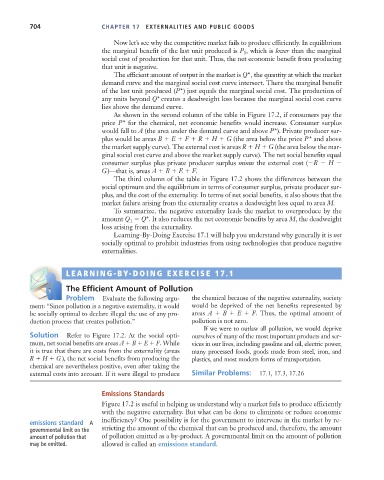Page 730 - Microeconomics, Fourth Edition
P. 730
c17ExternalitiesandPublicGoods.qxd 8/22/10 4:56 AM Page 704
704 CHAPTER 17 EXTERNALITIES AND PUBLIC GOODS
Now let’s see why the competitive market fails to produce efficiently. In equilibrium
the marginal benefit of the last unit produced is P , which is lower than the marginal
1
social cost of production for that unit. Thus, the net economic benefit from producing
that unit is negative.
The efficient amount of output in the market is Q* , the quantity at which the market
demand curve and the marginal social cost curve intersect. There the marginal benefit
of the last unit produced (P*) just equals the marginal social cost. The production of
any units beyond Q* creates a deadweight loss because the marginal social cost curve
lies above the demand curve.
As shown in the second column of the table in Figure 17.2, if consumers pay the
price P* for the chemical, net economic benefits would increase. Consumer surplus
would fall to A (the area under the demand curve and above P*). Private producer sur-
plus would be areas B E F R H G (the area below the price P* and above
the market supply curve). The external cost is areas R H G (the area below the mar-
ginal social cost curve and above the market supply curve). The net social benefits equal
consumer surplus plus private producer surplus minus the external cost ( R H
G)—that is, areas A B E F.
The third column of the table in Figure 17.2 shows the differences between the
social optimum and the equilibrium in terms of consumer surplus, private producer sur-
plus, and the cost of the externality. In terms of net social benefits, it also shows that the
market failure arising from the externality creates a deadweight loss equal to area M.
To summarize, the negative externality leads the market to overproduce by the
amount Q Q*. It also reduces the net economic benefits by area M, the deadweight
1
loss arising from the externality.
Learning-By-Doing Exercise 17.1 will help you understand why generally it is not
socially optimal to prohibit industries from using technologies that produce negative
externalities.
LEARNING-BY-DOING EXERCISE 17.1
S
D
E
The Efficient Amount of Pollution
Problem Evaluate the following argu- the chemical because of the negative externality, society
ment: “Since pollution is a negative externality, it would would be deprived of the net benefits represented by
be socially optimal to declare illegal the use of any pro- areas A B E F. Thus, the optimal amount of
duction process that creates pollution.” pollution is not zero.
If we were to outlaw all pollution, we would deprive
Solution Refer to Figure 17.2. At the social opti- ourselves of many of the most important products and ser-
mum, net social benefits are areas A B E F. While vices in our lives, including gasoline and oil, electric power,
it is true that there are costs from the externality (areas many processed foods, goods made from steel, iron, and
R H G ), the net social benefits from producing the plastics, and most modern forms of transportation.
chemical are nevertheless positive, even after taking the
external costs into account. If it were illegal to produce Similar Problems: 17.1, 17.3, 17.26
Emissions Standards
Figure 17.2 is useful in helping us understand why a market fails to produce efficiently
with the negative externality. But what can be done to eliminate or reduce economic
inefficiency? One possibility is for the government to intervene in the market by re-
emissions standard A
governmental limit on the stricting the amount of the chemical that can be produced and, therefore, the amount
amount of pollution that of pollution emitted as a by-product. A governmental limit on the amount of pollution
may be emitted. allowed is called an emissions standard.

